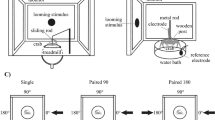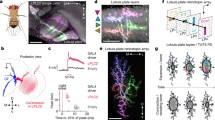Abstract
When confronted with predators, animals are forced to take crucial decisions such as the timing and manner of escape. In the case of the crab Chasmagnathus, cumulative evidence suggests that the escape response to a visual danger stimulus (VDS) can be accounted for by the response of a group of lobula giant (LG) neurons. To further investigate this hypothesis, we examined the relationship between behavioral and neuronal activities within a variety of experimental conditions that affected the level of escape. The intensity of the escape response to VDS was influenced by seasonal variations, changes in stimulus features, and whether the crab perceived stimuli monocularly or binocularly. These experimental conditions consistently affected the response of LG neurons in a way that closely matched the effects observed at the behavioral level. In other words, the intensity of the stimulus-elicited spike activity of LG neurons faithfully reflected the intensity of the escape response. These results support the idea that the LG neurons from the lobula of crabs are deeply involved in the decision for escaping from VDS.




Similar content being viewed by others
References
Alvarez-Buylla A, Kirn JR (1997) Birth, migration, incorporation, and death of vocal control neurons in adult songbirds. J Neurobiol 33:585–601
Aréchiga H, Rodríguez-Sosa L (2002) Distributed circadian rhythmicity in the crustacean nervous system. In: Wiese K (Ed) The crustacean nervous system. Springer, Berlin, pp 113–122
Aréchiga H, Wiersma AG (1969) Circadian rhythm of responsiveness in crayfish visual units. J Neurobiol 1:71–85
Bachmann S, Martinez MM (1999) Feeding tactics of the american oystercatcher (Haematopus palliatus) on Mar Chiquita coastal lagoon, Argentina. Ornit Neurotr 10:81–84
Berón de Astrada M, Sztarker J, Tomsic D (2001) Visual interneurons of the crab Chasmagnathus studied by intracellular recordings in vivo. J Comp Physiol A 187:37–44
Berón de Astrada M, Tomsic D (2002) Physiology and morphology of visual movement detector neurons in a crab (Decapoda: Brachyura). J Comp Physiol A 188:539–551
Cannicci S, Barelli C, Vannini M (2000) Homing in the swimming crab Thalamita crenata: a mechanism based on underwater landmark memory. Anim Behav 60:203–210
D’Incao F, Ruffino ML, Silva KG (1988) In: Notas preliminares sobre a ecologia de Chasmagnathus granulata (Dana, 1851) na barra de Rio Grande (Decapoda, Grapsidea) resumos XV congressos Brasileiros de zoologia, Curitiva, p 93
Edwards DH, Heitler WJ, Krasne FB (1999) Fifty years of a command neuron: the neurobiology of escape behavior in the crayfish. Trends Neurosci 22:153–161
Ewert JP (1980) Neuroethology: an introduction to the neurophysiological fundamentals of behavior. Springer
Ewert JP (1987) Neuroethology of the releasing mechanism: prey-catching behavior in toads. Behav Brain Sci 10:337–405
Ewert JP (1997) Neural correlates of key stimulus and releasing mechanism: a case study and two concepts. Trends Neurosci 230:332–339
Ewert JP, Siefert G (1974a) Neuronal correlates of seasonal changes in contrast-detection of pray catching behavior in toads (Bufo bufo L.). Vision Res 14:431–432
Ewert JP, Siefert G (1974b) Seasonal change of contrast detection in the toad’s Bufo bufo (L.) visual system. J Comp Physiol A 94:177–186
Ewert JP, Borchers HW, Wietersheim A (1978) Question of prey feature detectors in the toad’s Bufo bufo (L.) visual system: a correlation analysis. J Comp Physiol A 126:43–47
Fleissner G, Fleissner G (2006) Endogenous control of visual adaptation in invertebrates. In: Warrant E, Nilson D-E (Eds) Invertebrate vision. Cambridge University Press, Cambridge, pp 127–166
Freudenthal R, Romano A (2000) Participation of Rel/NF-kappaB transcription factors in long-term memory in the crab Chasmagnathus. Brain Res 855:274–281
Groves PM, Lee D, Thompson RF (1969) Effects of stimulus frequency and intensity on habituation and sensitization in acute spinal cat. Physiol Behav 4:383–388
Hemmi JM, Zeil J (2003) Robust judgment of inter-object distance by an arthropod. Nature 421:160–163
Hemmi JM (2005) Predator avoidance in fiddler crabs: 1. Escape decisions in relation to the risk of predation. Anim Behav 69:603–614
Hermitte G, Aggio J, Maldonado H (1995) Failure of interocular transfer in two types of learning in the crab Chasmagnathus. J Comp Physiol A 177:371–378
Jennions MD, Backwell PR, Murai M, Christy JH (2003) Hiding behavior in fiddler crabs: how long should prey hide in response to a potential predator? Anim Behav 66:251–257
Johnson AP, Horseman BG, Macauley MW, Barnes WJ (2002) PC-based visual stimuli for behavioural and electrophysiological studies of optic flow field detection. J Neurosci Methods 114:51–61
Korn H, Faber DS (2005) The Mauthner cell half a century later: a neurobiological model for decision-making? Neuron 47:13–28
Kucharski LCR, Da Silva RSM (1991) Effect of diet composition on carbohydrate and lipid metabolism in an estuarian crab, C. granulata (Dana, 1851). Comp Biochem Physiol 99:215–218
Land MF, Layne J (1995a) The visual control of behaviour in fiddler crabs: I. Resolution, thresholds and the role of the horizon. J Comp Physiol A 177:81–90
Land MF, Layne J (1995b) The visual control of behavior in fiddler crabs: II. Tracking control systems in courtship and defense. J Comp Physiol A 177:91–103
Layne J, Land M, Zeil J (1997) Fiddler crabs use the visual horizon to distinguish predators from conspecifics: a review of the evidence. J Mar Biol Ass UK 77:43–54
Lozada M, Romano A, Maldonado H (1990) Long term habituation to a danger stimulus in the crab Chasmagnathus granulatus. Phys Behav 47:35–41
Medan V, Oliva D, Tomsic D (2007) Characterization of lobula giant neurons responsive to visual stimuli that elicit escape behaviors in the crab Chasmagnathus. J Neurophysiol 98:2414–2428
Merlo E, Romano A (2007) Long-term memory consolidation depends on proteasome activity in the crab Chasmagnathus. Neurosci 147:46–52
Nalbach HO (1990) Discontinuous turning reaction during escape in soldier crabs. J Exp Biol 148:483–487
Nottebohm F (1989) From bird song to neurogenesis. Sci Am 260:74–79
Oliva D, Medan V, Tomsic D (2007) Escape behavior and neuronal responses to looming stimuli in the crab Chasmagnathus granulatus (Decapoda: Grapsidae). J Exp Biol 210:865–880
Pedreira ME, Maldonado H (2003) Protein synthesis subserves reconsolidation or extinction depending on reminder duration. Neuron 38:863–869
Pedreira ME, Pérez-Cuesta L, Maldonado H (2002) Reactivation and reconsolidation of long-term memory in the crab Chasmagnathus: protein synthesis requirement and mediation by NMDA-type glutamatergic receptors. J Neurosci 22:8305–8311
Pedreira ME, Pérez-Cuesta L, Maldonado H (2004) Mismatch between what is expected and what actually occurs triggers memory reconsolidation or extinction. Learn Mem 11:579–585
Pereyra P, González Portino E, Maldonado H (2000) Long-lasting and context-specific freezing preference is acquired after spaced repeated presentations of a danger stimulus in the crab Chasmagnathus. Neurobiol Learn Mem 74:119–134
Pereyra P, Saraco M, Maldonado H (1999) Decreased response or alternative defensive strategies in escape: two different types of long-term memory in the crab Chasmagnathus. J Comp Physiol A 184:301–310
Rakitin A, Tomsic D, Maldonado H (1991) Habituation and sensitization to an electrical shock in the crab Chasmagnathus. Effect of background illumination. Phys Behav 50:477–487
Rodríguez-Sosa L, De la Vega MT, Vergara P, Aréchiga H (1997) Seasonal rhythm of red pigment-concentrating hormone in the crayfish. Chronobiol Int 14:639–645
Rosas C, Sanchez A, Escobar E, Soto L, Bolongaro-Crevenna A (1992) Daily variations of oxygen consumption and glucose hemolymph level related to morphophysiological and ecological adaptations of crustacea. Comp Biochem Physiol 101:323–328
Santer RD, Rind FC, Stafford R, Simmons PJ (2006) Role of an identified looming-sensitive neuron in triggering a flying locust’s escape. J Neurophysiol 95:3391–3400
Simmons P, Young D (1999) Nerve cells and animal behavior, (2nd Ed). Cambridge University Press
Strausfeld NJ (2005) Evolution of crustacean optic lobes and origins of chiasmata. Arthropod Struct Dev 34:235–56
Sztarker J (2000) Interneuronas monoculares y binoculares: indicios funcionales de la organización circuital del sistema visual en el cangrejo Chasmagnathus. Licenciate thesis, Universidad de Buenos Aires
Sztarker J, Strausfeld NJ, Tomsic D (2005) Organization of optic lobes that support motion detection in a semiterrestrial crab. J Comp Neurol 493:396–411
Sztarker J, Tomsic D (2004) Binocular visual integration in the crustacean nervous system. J Comp Physiol A 190:951–962
Thompson RF, Spencer WA (1966) Habituation: a model phenomenon for the study of neuronal substrates of behavior. Psychol Rev 73:16–43
Tinbergen N (1951) The study of instinct. Clarendon Press, Oxford
Tinbergen N, Perdeck AC (1950) On the stimulus situation releasing the begging responses in the newly hatched Herring Gull chick (Larus argentatus Pont.). Behaviour 3:1–38
Tomsic D (2002) Visual learning in crabs investigated by intracellular recordings in vivo. In: Wiese K (ed) The crustacean nervous system. Springer, Berlin, pp 328–335
Tomsic D, Berón de Astrada M, Sztarker J (2003) Identification of individual neurons reflecting short- and long-term visual memory in an arthropod. J Neurosci 23:8539–8546
Tomsic D, Massoni V, Maldonado H (1993) Habituation to a danger stimulus in two semiterrestrial crabs. Ontogenic, ecological and opioid system correlates. J Comp Physiol A 173:621–633
Tomsic D, Pedreira ME, Romano A, Hermitte G, Maldonado H (1998) Context-US association as a determinant of long-term habituation in the crab Chasmagnathus. Ani Learn Behav 26:196–209
Zeil J, Hemmi JM (2006) The visual ecology of fiddler crabs. J Comp Physiol A 192:1–25
Acknowledgments
We would like to thank John Tuthill for corrections to this manuscript. This work was supported by postdoctoral fellowships from the National Research Council of Argentina (CONICET) to J.S. and from the following research grants to D.T.: Universidad de Buenos Aires, grant number X 173; ANPCYT, grant number PICT 12300/02.
Author information
Authors and Affiliations
Corresponding author
Rights and permissions
About this article
Cite this article
Sztarker, J., Tomsic, D. Neuronal correlates of the visually elicited escape response of the crab Chasmagnathus upon seasonal variations, stimuli changes and perceptual alterations. J Comp Physiol A 194, 587–596 (2008). https://doi.org/10.1007/s00359-008-0333-3
Received:
Revised:
Accepted:
Published:
Issue Date:
DOI: https://doi.org/10.1007/s00359-008-0333-3




